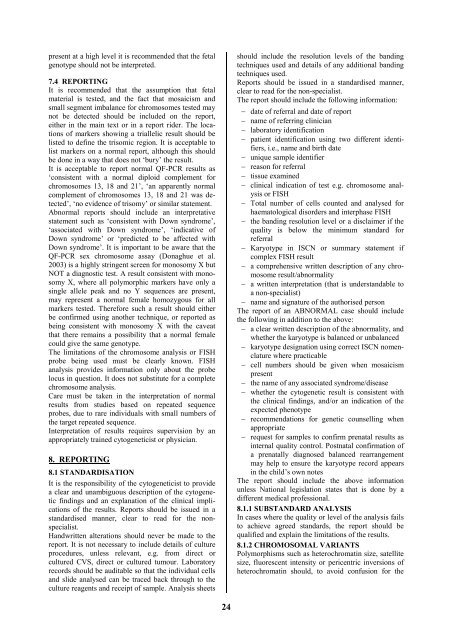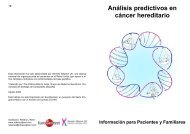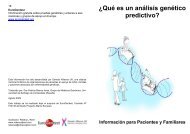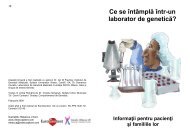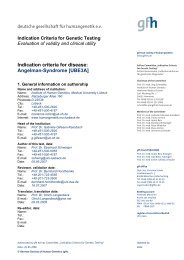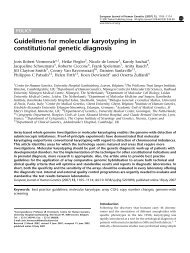Cytogenetic Guidelines and Quality Assurance - EuroGentest
Cytogenetic Guidelines and Quality Assurance - EuroGentest
Cytogenetic Guidelines and Quality Assurance - EuroGentest
Create successful ePaper yourself
Turn your PDF publications into a flip-book with our unique Google optimized e-Paper software.
present at a high level it is recommended that the fetal<br />
genotype should not be interpreted.<br />
7.4 REPORTING<br />
It is recommended that the assumption that fetal<br />
material is tested, <strong>and</strong> the fact that mosaicism <strong>and</strong><br />
small segment imbalance for chromosomes tested may<br />
not be detected should be included on the report,<br />
either in the main text or in a report rider. The locations<br />
of markers showing a triallelic result should be<br />
listed to define the trisomic region. It is acceptable to<br />
list markers on a normal report, although this should<br />
be done in a way that does not ‘bury’ the result.<br />
It is acceptable to report normal QF-PCR results as<br />
‘consistent with a normal diploid complement for<br />
chromosomes 13, 18 <strong>and</strong> 21’, ‘an apparently normal<br />
complement of chromosomes 13, 18 <strong>and</strong> 21 was detected’,<br />
‘no evidence of trisomy’ or similar statement.<br />
Abnormal reports should include an interpretative<br />
statement such as ‘consistent with Down syndrome’,<br />
‘associated with Down syndrome’, ‘indicative of<br />
Down syndrome’ or ‘predicted to be affected with<br />
Down syndrome’. It is important to be aware that the<br />
QF-PCR sex chromosome assay (Donaghue et al.<br />
2003) is a highly stringent screen for monosomy X but<br />
NOT a diagnostic test. A result consistent with monosomy<br />
X, where all polymorphic markers have only a<br />
single allele peak <strong>and</strong> no Y sequences are present,<br />
may represent a normal female homozygous for all<br />
markers tested. Therefore such a result should either<br />
be confirmed using another technique, or reported as<br />
being consistent with monosomy X with the caveat<br />
that there remains a possibility that a normal female<br />
could give the same genotype.<br />
The limitations of the chromosome analysis or FISH<br />
probe being used must be clearly known. FISH<br />
analysis provides information only about the probe<br />
locus in question. It does not substitute for a complete<br />
chromosome analysis.<br />
Care must be taken in the interpretation of normal<br />
results from studies based on repeated sequence<br />
probes, due to rare individuals with small numbers of<br />
the target repeated sequence.<br />
Interpretation of results requires supervision by an<br />
appropriately trained cytogeneticist or physician.<br />
8. REPORTING<br />
8.1 STANDARDISATION<br />
It is the responsibility of the cytogeneticist to provide<br />
a clear <strong>and</strong> unambiguous description of the cytogenetic<br />
findings <strong>and</strong> an explanation of the clinical implications<br />
of the results. Reports should be issued in a<br />
st<strong>and</strong>ardised manner, clear to read for the nonspecialist.<br />
H<strong>and</strong>written alterations should never be made to the<br />
report. It is not necessary to include details of culture<br />
procedures, unless relevant, e.g. from direct or<br />
cultured CVS, direct or cultured tumour. Laboratory<br />
records should be auditable so that the individual cells<br />
<strong>and</strong> slide analysed can be traced back through to the<br />
culture reagents <strong>and</strong> receipt of sample. Analysis sheets<br />
24<br />
should include the resolution levels of the b<strong>and</strong>ing<br />
techniques used <strong>and</strong> details of any additional b<strong>and</strong>ing<br />
techniques used.<br />
Reports should be issued in a st<strong>and</strong>ardised manner,<br />
clear to read for the non-specialist.<br />
The report should include the following information:<br />
date of referral <strong>and</strong> date of report<br />
name of referring clinician<br />
laboratory identification<br />
patient identification using two different identifiers,<br />
i.e., name <strong>and</strong> birth date<br />
unique sample identifier<br />
reason for referral<br />
tissue examined<br />
clinical indication of test e.g. chromosome analysis<br />
or FISH<br />
Total number of cells counted <strong>and</strong> analysed for<br />
haematological disorders <strong>and</strong> interphase FISH<br />
the b<strong>and</strong>ing resolution level or a disclaimer if the<br />
quality is below the minimum st<strong>and</strong>ard for<br />
referral<br />
Karyotype in ISCN or summary statement if<br />
complex FISH result<br />
a comprehensive written description of any chromosome<br />
result/abnormality<br />
a written interpretation (that is underst<strong>and</strong>able to<br />
a non-specialist)<br />
name <strong>and</strong> signature of the authorised person<br />
The report of an ABNORMAL case should include<br />
the following in addition to the above:<br />
a clear written description of the abnormality, <strong>and</strong><br />
whether the karyotype is balanced or unbalanced<br />
karyotype designation using correct ISCN nomenclature<br />
where practicable<br />
cell numbers should be given when mosaicism<br />
present<br />
the name of any associated syndrome/disease<br />
whether the cytogenetic result is consistent with<br />
the clinical findings, <strong>and</strong>/or an indication of the<br />
expected phenotype<br />
recommendations for genetic counselling when<br />
appropriate<br />
request for samples to confirm prenatal results as<br />
internal quality control. Postnatal confirmation of<br />
a prenatally diagnosed balanced rearrangement<br />
may help to ensure the karyotype record appears<br />
in the child’s own notes<br />
The report should include the above information<br />
unless National legislation states that is done by a<br />
different medical professional.<br />
8.1.1 SUBSTANDARD ANALYSIS<br />
In cases where the quality or level of the analysis fails<br />
to achieve agreed st<strong>and</strong>ards, the report should be<br />
qualified <strong>and</strong> explain the limitations of the results.<br />
8.1.2 CHROMOSOMAL VARIANTS<br />
Polymorphisms such as heterochromatin size, satellite<br />
size, fluorescent intensity or pericentric inversions of<br />
heterochromatin should, to avoid confusion for the


